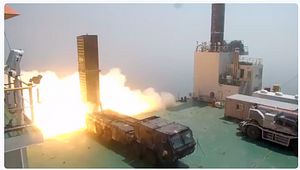Republic of Korea (ROK) President Moon Jae-in and U.S. President Donald Trump finally agreed to completely scrap warhead weight limits for South Korean ballistic missiles during a bilateral summit between the two head of states held at the South Korean presidential office Cheong Wa Dae in Seoul on November 7, according to local media reports.
“The heads of South Korea and the United States reached a final agreement on removing the limit on missile payloads,” the South Korean president said in a joint press conference on Tuesday. This final agreement follows a September 4 telephone conversation between the 2 presidents during which the American president agreed to scrap the limit in-principle.
The ROK request to develop more powerful ballistic missiles has been under consideration by the United States for a while. The U.S. Department of Defense has been reviewing guidelines agreed to 1979 in consultation with the U.S. State Department to determine next steps. As I reported earlier:
In a bilateral agreement signed in 1979, the United States and South Korea set out guidelines about the specific payload and range of the latter’s domestically developed missiles in order to avoid a regional arms race. These guidelines were updated in 2012. However, while South Korean missiles can have now an extended range of up to 800 kilometers (about 500 miles), the maximum payload remains unchanged at 500 kilograms (1,102 pounds).
In a October 2017 report for an annual parliamentary audit by the South Korean National Assembly’s Defense Committee, the ROK Army announced that it is working on a new surface-to-surface ballistic missile, likely designated Hyunmoo IV, that most likely will be fitted with a new 1,000-kilogram (2,200-pound) warhead. This new missile, dubbed “Frankenmissile, by the media, is probably a variant of the extended-range Hyunmoo (likely designated 2c) missile currently under development.
As I noted previously:
The new Hyunmoo missile, with an estimated range of 800 kilometers, has been repeatedly test-fired in 2017. According to ROK Army reports, the new missile’s payload remains pegged at 500 kilograms. However, the missile could quickly be modified to accommodate a heavier warhead.
The extended-range Hyunmoo missile is expected to become operational by the end of 2017 following two more rounds of test firing.
The ROK military currently deploys two ballistic missiles, the Hyunmoo 2A and 2B. The extended-range Hyunmoo is an improved variant of the Hyunmoo 2B. It is unclear when the new Hyunmoo IV, a deep precision-strike capable missile, will be operational.
Conversely, the United States and South Korea would need to officially update the guidelines before missiles can officially be fitted with more powerful payloads. As of now, it is unclear when the new ROK-U.S. guidelines will come into force. The ROK military has been working on fielding deep precision strike capabilities for a number of years, however this would require more effective and reliable intelligence, surveillance and reconnaissance (ISR) capabilities within the armed forces.
“ [D]eep precision-strike capable missiles are part of Seoul’s deterrence strategy vis-à-vis Pyongyang, known as Korea Massive Punishment & Retaliation (KMPR),” as I explained in July. “KMPR foresees precision strikes with ballistic missiles, cruise missiles, air-launched missiles and special operations forces against North Korean leader Kim Jong-un and the country’s military leadership in the event of a nuclear attack.”

































